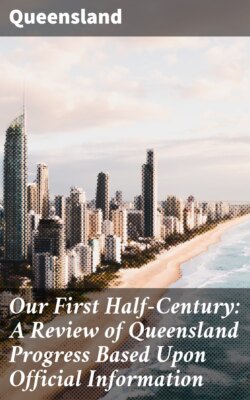Читать книгу Our First Half-Century: A Review of Queensland Progress Based Upon Official Information - Queensland - Страница 67
На сайте Литреса книга снята с продажи.
QUEENSLAND IN 1860.
ОглавлениеTable of Contents
Rush of Population.—High Prices for Stock for occupying New Country.—Sparse Population.—Rockhampton most Northerly Port of Entry.—Navigation inside Barrier Reef unknown.—Tropical Queensland Unexplored.—Ignorance of Climate, Resources, and Conditions.—Primary Industries in 1860.—Primitive Means of Communication.—Public Revenue, Bank Deposits, and Institutions.
Thus was Queensland fairly launched on her career as a self-governing state of the Empire. The very announcement of impending separation had caused a rush of population from the southern colonies; while even the Crown tenants, who had for years regarded the movement with aversion, found much compensation in their escape from the operation of the imminent Robertson land law which threatened free selection before survey throughout the entire area of New South Wales. The rush for new pastoral country not only attracted the most adventurous bushmen in Australia to the new colony, but also sent up the prices of sheep and cattle to fabulous rates, as country tendered for could not be held unless stocked to the prescribed minimum number. At the time a large area of coast country was occupied by sheep, and symptoms of disease were so menacing that the sales for stocking up new country proved the salvation of some of the "inside" squatters; although looked at in the light of experience it may be doubted whether the too rapid occupation of the wilderness country, then inhabited solely by the aborigines, was not partly accountable for disastrous results when the demand for stocking up ceased, and the natural water on most runs proved wholly insufficient to carry stock through the mildest drought. Still, at the time Queensland attracted a population of seasoned Australians whose colonising value was inestimable; and these in addition to many immigrants from the mother country. Consequently the colony made phenomenal progress.
A glance at the official statistics for the year 1860—the earliest available—will illustrate the insignificance, compared with the vast area of the territory held, of the population, trade, and liquid capital of the community. The total population on 31st December, 1860, was estimated at 28,056, most of these people being more or less concentrated in the towns. The rest were scattered sparsely over the country between the southern boundary and the tropic of Capricorn for a distance of about 250 miles back from the coast-line. Rockhampton was then the most northerly port of entry; the site of the present town of Bundaberg was virgin forest, the entrance to the Burnett River from Hervey Bay being as yet unknown; Mackay, Bowen, Townsville, Ingham, Geraldton, Cairns, Port Douglas, Cooktown, and the Thursday Island settlement were non-existent; and of the coast waters beyond Keppel Bay little more was known than the narratives of Captain Cook and Lieutenant Flinders at the close of the eighteenth century disclosed.
The existence of the magnificent natural harbour of 1,000 miles in length formed by the Great Barrier Reef was undreamt of; the passage was regarded rather as one of Nature's traps for the unwary navigator than the future safe and easily traversed route of great steamship lines along a coast dotted with prosperous ports kept busy as the outlets of a richly productive hinterland.
The tropical climate of the northern coast lands was then supposed to be deadly to members of the white races; the interior was declared to be almost entirely devoid of surface water—for the greater part of the year a fiery furnace, and at intervals of capricious periodicity ravaged by destructive floods. It was assumed to be a country where the white man would wither and the coloured man thrive—a land wholly unfit for the home of civilised peoples, and only adapted to the wants of the degraded aboriginal native. It was ignorantly affirmed that the sheep stations intended to be formed in the far western country must be failures, and English experts held that under the tropical sun the sheep, if it could live in Queensland at all, would soon carry hair instead of wool. Even in Southern Queensland the agricultural possibilities of the land were sadly unappreciated. True, in the population centres there were loud preachers of the gospel of reclamation of the wilderness so that it might bud and blossom as the rose; but their homilies for the most part fell upon deaf ears—the seasoned bushman, like the great squatter, tenaciously held that even the Darling Downs would not grow a cabbage.
So backward was the farming industry that in 1860 the total area under cultivation was 3,353 acres in a country of greater extent than France and Germany combined. Of this trifling cultivated area only 196 acres were under wheat, and not an acre under sugar-cane. True, there were nearly three and a-half million sheep, half-a-million cattle, and 24,000 horses finding subsistence on the limitless but ill-watered natural pastures. But at that time the annual clip from the sheep, though wool was the chief export of the colony, totalled only 5,000,000 lb., or equal to about 1½ lb. to each fleece. Mining, except for coal, of which 12,327 tons was raised in 1860, was almost non-existent, although 2,738 fine ounces of gold are shown by the statistics to have been won during the year.
